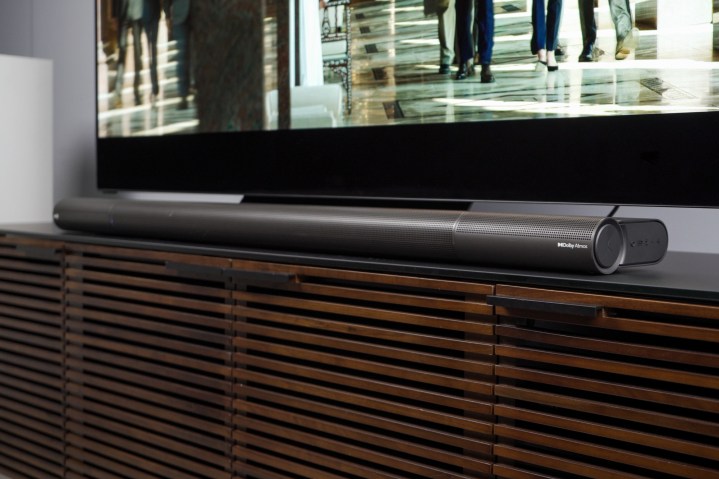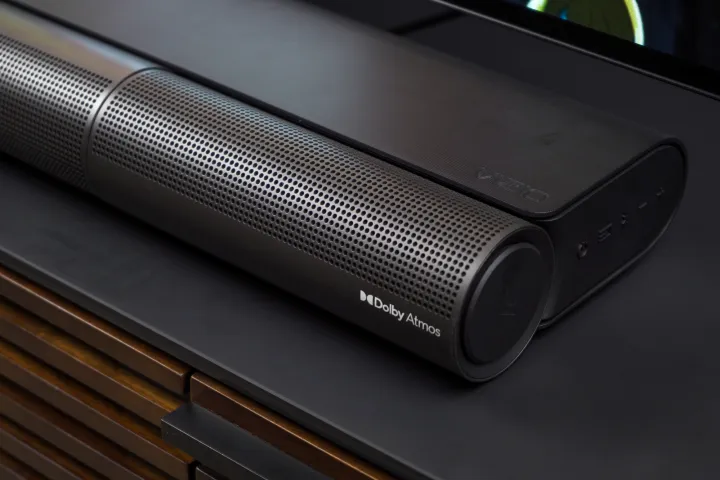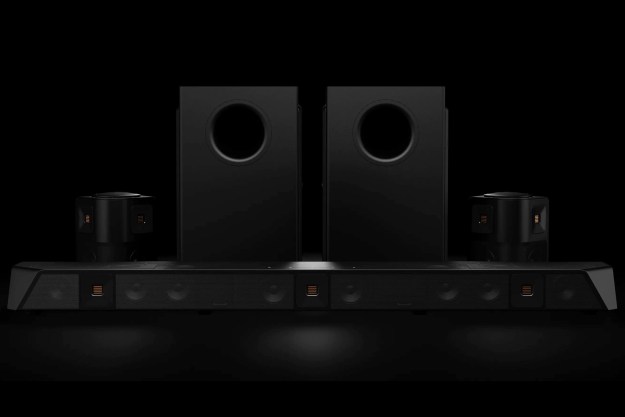“With rain so realistic, you’ll be reaching for an umbrella, the Elevate delivers immersive audio at its finest.”
- Simple setup, clear chart showing connections
- Wonderfully unique design
- Deep control over sound output levels
- Exceptionally clear dialogue
- Effects dependent on room
- Costly
If you’re looking to crank the sound in your home to match that ultra-high-quality picture you’ve invested in — and I think you should, it’s one of the best ways to enhance movie night — there’s no more convenient way than a Dolby Atmos soundbar system. The picture quality of your set is amazing, right? Why isn’t the sound equally stunning?
Vizio thinks a soundbar can be a statement piece as well. Its new 48-inch Elevate soundbar features speaker pods that rotate to fire up at the ceiling or straight out at you. Sounds amazing, right? The problem with these systems is they tend to make some kind of compromise or sacrifice. Vizio says its Elevate soundbar makes no compromises — and the $1,000 price tag would point toward that being the case. But does it live up to the hype? We’re about to find out.
What’s in the box: Unpacking the Vizio Elevate
Along with the speakers themselves – carefully packaged in a rather elaborate chair-shaped box — comes an accessories box, and I love what Vizio’s done here: Not only is everything that you need to get set up inside this box, but it’s also very clearly labeled and in some cases color-coded. Two different power cables are included, one for the sub and one for the soundbar, but you can use the longer one for whichever you want.

Also in the box are the remote (batteries included), a digital optical cable, an HDMI cable, mounting brackets and hardware, and two analog audio cables. One audio cable could be for a smart speaker, the other for pretty much any other device that you would want to connect to the soundbar.
The bar itself is slender and cylindrical, with a satin silver finish and clean lines. What’s really interesting is the cutout area on the underside that’s designed specifically for this soundbar to sit directly on Vizio’s H1 OLED TV. Remove it and the pair nestle carefully together; keep the cutout attached if you don’t own a Vizio TV.
The surround speakers are nice and compact, meaning they won’t take up too much space in your room. The Atmos driver fires out of the top of each surround speaker, while the bottom holds a nice little antiskid silicone pad. On the back of the speaker, you’ll notice a screw hole for wall mounting, as well as color-coded RCA speaker connections.
The subwoofer is a little bit larger than what you get with most soundbars, and that’s on purpose: The cabinet volume is meant to support an enormous eight-inch driver, which looks very robust. The rear of the sub has a nicely flared output port up top, which is going to help eliminate air noise when the Elevate is really thumping. Down below are a couple of spots to plug in your surround speakers.
Between the soundbar, surrounds, and subwoofer, the Elevate system includes 18 drivers powered by enough watts of power for the system to hit an ear-splitting 107 decibels. The subwoofer gets down to 30hz, which is deep enough in the bass range to rattle pictures off your wall, but just shy of the deepest bass you would get from a high-end subwoofer – in other words, you’ll be feeling the bass.
Connections

Underneath the soundbar itself, you’ll find your optical digital connection on the left and two aux connections — one of them interestingly labeled for a smart speaker — on the right-hand side. There are two HDMI inputs that let you hook two devices directly to the soundbar and a third HDMI port for an e-ARC connection. The first two will send signal up to your TV, while the e-ARC connection accepts downstream audio from the TV.
Setup
Getting the system set up is really a piece of cake. Take your subwoofer and put it in the back of the room near a power outlet so you can plug it in. Where you place your subwoofer in your room is important because your surround speakers need to connect directly to the subwoofer. That’s right, the surround signal goes first to the subwoofer, where an amplifier drives those surround speakers. Sure, they have really long wires, so you’ve got some flexibility in placement for all those components, but broadly speaking, front versus back of the room is dictated by this connection.
The soundbar itself can sit in front of the TV, on the bracket on your Vizio OLED TV, or you can wall-mount it using the included brackets. When it comes to connections, you can simply run one HDMI cable from your TV to the Vizio Elevate using the ARC or eARC port on each device — and that’s really all you need to do to start getting sound.
Getting things synced is pretty much automatic: Turn it on and you’re ready to go. Unfortunately, while setting up the soundbar system itself is a piece of cake, making sure that you get Dolby Atmos is a bit more complicated.

If you have a really new TV — 2018 or newer — then you’re probably going to be just fine. Most new televisions support Atmos passthrough, which means that you can connect devices to the TV (or use the built-in streaming apps), and you’re going to get Dolby Atmos passed down to the soundbar. If your TV is a little bit older, it probably doesn’t support Atmos passthrough, so you’ll want to connect devices directly to one of the two HDMI ports in the soundbar itself.
Then it gets a little bit more complicated.
First, make sure that the game console or disc player or streaming device that you own supports Atmos – a quick spin through the manual or the product website should confirm this. On top of that, you’ll need to make sure that the streaming app that you’re using — Netflix or Disney+ or whatever — actually streams Dolby Atmos on that particular device, because it’s not consistent: Netflix may stream Atmos on the Xbox One X, for instance, but not on a given streaming stick. So check the chain — all the different components you’ll be using need to support Atmos.
The same goes for DTS:X, every source and device in the chain needs to be double-checked.
Versatility
One of the things that bug me most about soundbars in general, but especially Dolby Atmos soundbars, is that I don’t get control over the individual levels that I need. That changes with the Vizio Elevate soundbar, which offers control over everything: Left, right, center, surround level, surround balance, Atmos height channel effects, the subwoofer level, bass, treble — you name it. Why is this important? Let’s say, for example, that I can’t put the surround speakers exactly where they should be (which, by the way, is just back to the left- and right-hand corners of your seating area). With individual level adjustments, you can tweak your setup to get really good Atmos height effects and surround effects no matter where those speakers are placed.

One of the other things that bug me about soundbars is that they tend to lean on color-coded LED systems to let you know important things, such as which input you’re tuned to or what EQ mode you’ve selected. Vizio’s Elevate does this as well, of course, but at least they’ve made it easy to understand: A chart right on the back of the remote tells you which color means what.
There’s also a readout right on top of the remote that tells you pretty much anything you need to know and is activated when you’re managing all your different settings in the soundbar. In other words, you’re not going to get an on-screen interface with this bar — but really, between the chart on the remote and that little screen, you’ve got all the information that you need. On top of that, there’s actually a voice that tells you what input you’re tuned to when you switch.
Performance
The Elevate soundbar’s Dolby Atmos execution is unique. Sure, the surround speakers are traditional, with some drivers that point into the room and others that point up at the ceiling. The soundbar itself is different: Speakers on either end of its front tube rotate between Atmos mode and standard audio. When the sound ar senses a Dolby Atmos signal, those speakers roll up and start firing sound at the ceiling — that’s how you get a 5.1.4 Atmos experience. (Why four? Two speakers in the front and two in the surround speakers, all pointing at the ceiling.)
When you’re not listening to Atmos content, the speakers roll down, and when this happens, the Elevate changes how it assigns sound to the various woofers and tweeters in the sound system, effectively giving you better fidelity and a wider sound stage — at least that’s the promise. That also means this soundbar could sound excellent for music.

But let’s be honest, the Elevate is here to produce amazing soundtracks for movies and dazzling Atmos effects, and, my word, does it ever do that. This soundbar just sounds really, really good. The Atmos effects will vary depending on your ceiling type, but there’s clearly enough range. You can goose them to get more out of them, leading to a truly amazing experience: Helicopters that truly fly overhead, or rain so realistic you’ll be reaching for an umbrella.
With the Elevate, you get the sense that you’ve got action happening up above you, but more than that, the transition from the soundbar to the surround speakers to the Atmos effects are all extremely smooth — I don’t hear any holes in the sphere of sound, it’s all very contiguous. What does that mean? It’s simple: When you’re enjoying a movie, you won’t find yourself thinking about the sound-bar, you’re just lost in the film. The fidelity of this soundbar comes into play here as well, with very clear dialogue that’s not overly accented, which has been a problem before.
There’s nothing boxy about this system. It has a very open sound to it that’s extremely dynamic as well, so when things get explosive, they’re really explosive, and when things are more delicate and quiet, you hear all of the nuance. The tweeters Vizio has included here are really sweet: They don’t shout at you, they don’t get overly sibilant — it’s just a really enjoyable sound signature across the board.
Our take
Did Vizio deliver on its promise of a no-compromise soundbar? I’ll say this: I think it has done better than everybody else so far. The musicality of this soundbar is something I’m extremely impressed by, and that’s usually one of the biggest pain points. Control is immense, meaning audiophiles will be able to tune it to sound exactly the way they want. It’s also a very even, contiguous sound with great fidelity — another hallmark of a great soundbar.
Is there a better alternative?
If you’re considering the Elevate, you probably aren’t looking for something simple, such as the Bose Solo 5 TV sound system. You’re hoping for the top of the line, the cream of the crop, and there are certainly competitors out there. The Sonos Arc is another Swiss Army knife of speakers, for example, that also brings Dolby Atmos and offering A.I. controls – as well as a brand name sure to impress your friends. It’s got limited connectivity, however, with just a single HDMI port. Further up the rarefied line of high-end speaker systems sits the Bang & Olufsen Beosound Stage, which has a gorgeous design and deep and resonant bass. It’s also closing in on twice as expensive.
How long will it last?
The spec wars are ending, Dolby Atmos and DTS:X have won out, and you’re unlikely to see new, unsupported formats. Vizio has become well-known for its high-quality products, and this soundbar is likely to last you into the next decade.
Warranty
Vizio offers a standard 1-year warranty for the Elevate soundbar. You can find more information on Vizio’s warranty page.
Should you buy it?
Yes, absolutely. Marrying a killer new design to audiophile controls and simply stellar sound, the Vizio is the ultimate compliment to your high-end television.
Editors' Recommendations
- Best soundbar deals: Save on Bose, Samsung, Vizio, and more
- TCL goes all-in on Dolby Atmos with its first 7.1.4-channel soundbar
- The best soundbars under $500 for 2023
- Bose’s new flagship Dolby Atmos soundbar brings AI smarts to the dialogue problem
- Sennheiser’s Ambeo Soundbar Mini is a pricey, bedroom-sized Dolby Atmos speaker





